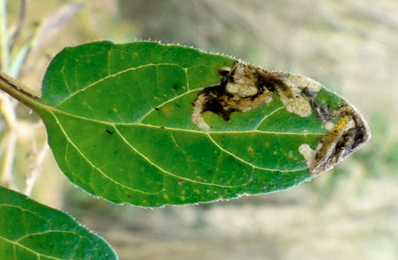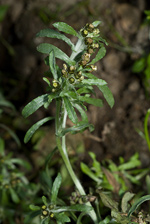|
||||||
|
GNAPHALIUM. Cudweeds. [Asteraceae] |
|
|
Eleven species of Gnaphalium are recorded in Britain. These include the native Jersey Cudweed (G. luteoalbum), Marsh Cudweed (G. uliginosum), Highland Cudweed (G. norvegicum), Dwarf Cudweed (G. supinum) and Heath Cudweed (G. sylvaticum). Jersey Cudweed (G. luteoalbum) is protected under Schedule 8 of the Wildlife and Countryside Act, 1981. Four British miners recorded on Gnaphalium. The polyphagous agromyzid Liriomyza trifolii has been recorded in quarantine in Britain (Pitkin & Plant in British leafminers). See also Liriomyza species in Glasshouses and/or Quarantine Interceptions. A key to the European miners recorded on Gnaphalium is provided in Bladmineerders van Europa. |
|
Key for the identification of the known mines of British |
1a > Leaf and Stem-miner: An external stem mine on Gnaphalium sylvaticum (Spencer, 1972b: 27). In the latter a single larva moves from leaf to leaf, each leaf with 2-4 broad diverging tracks extending rarely more than two-thirds of the length of the leaf from the petiole into the leaf lamina; frass concentrated in the petiolar part of the mine. Pupation in mine (Spencer, 1972b: 27). Mine in the leaf base of the lower leaves, often close to the midrib. From the leaf base corridors radiate into the leaf disk. Primary feeding lines in fresh mines well visible. Frass sparingly, granular. Puaparium in the mine, in the leaf base. |
|
Ophiomyia gnaphalii Hering, 1949 [Diptera: Agromyzidae]. |
1b > Leaf-miner: Mine linear, whitish, both upper and lower surface. Pupation internal, at the end of the mine with the anterior spiracles projecting through the epidermis (Spencer, 1976: 433). Upper-surface, less often lower-surface corridor. Frass in isolated grains. Pupation within the mine, usually in a lower-surface puparial chamber. A long whitish upper surface corridor, which eventually goes lower surface. |
|
Chromatomyia
horticola (Goureau, 1851) [Diptera: Agromyzidae] |
1d > Leaf-miner: A distinctive mine primarily above mid-rib, with irregular short lateral offshoots into leaf blade. Pupation external (Spencer, 1972: 51 (fig. 172), 55; Spencer, 1976: 270, 271 (fig. 486)). Branched, whitish, upper-surface corridor; main axis overlying the midrib; side branches overlying the main lateral veins. (In Campanula and Phyteuma the mine is much less branched, sometimes nothing more than a corridor on top of the midrib). Frass in rather long strings. Usually the mines begins as a long and narrow, shallow, tortuous lower-surface corridor that ends upon the midrib but otherwise is not associated with the leaf venation. Often this initial corridor is filled with callus, and then even less conspicuous. Pupation outside the mine. A linear mine on the upper surface, usually following the midrib and showing side branches along the veins. The frass is in strings. |
|
Liriomyza strigata (Meigen, 1830) [Diptera: Agromyzidae]. |
1e > Leaf-miner: Rather narrow corridor, untidy and sometimes branched, starting from the base of the leaf, in particular the midrib. Sides of the corridor irregularly eaten out, not really parallel. Frass mostly present, and then in a central line. The larva is capable of leaving the mine and start a new one elsewhere. These later mines are much broader, and the frass is scattered irregularly.. |
 Mine of Orthochaetes insignis on Prunella vulgaris Image: © Jean-Yves Baugnée (Bladmineerders van Europa) |
|
Orthochaetes insignis (Aube, 1863) [Coleoptera: Curculionidae]. |
| Last updated 05-Jul-2019 Brian Pitkin | ||

